Brick Renaissance is the Northern European continuation of brick architecture after Brick Romanesque and Brick Gothic. Although the term Brick Gothic is often used generally for all of this architecture, especially in regard to the Hanseatic cities of the Baltic, the stylistic changes that led to the end of Gothic architecture did reach Northern Germany and northern Europe with delay, leading to the adoption of Renaissance elements into brick building. Nonetheless, it is very difficult for non-experts to distinguish transitional phases or early Brick Renaissance, as the style maintained many typical features of Brick Gothic, such as stepped gables. A clearer distinction only developed at the transition to Baroque architecture. In Lübeck, for example, Brick Renaissance is clearly recognisable in buildings equipped with terracotta reliefs by the artist Statius von Düren, who was also active at Schwerin (Schwerin Castle) and Wismar (Fürstenhof).
More clearly recognisable as Renaissance are brick buildings strongly influenced by the Dutch Renaissance style, such as Reinbek Castle at Reinbek near Hamburg, the Zeughaus at Lübeck, or Friedrichstadt in Schleswig-Holstein.
Belarus
| Place | Building | Main period of construction | Special features | Image |
| Mir | Mir Castle | 15th-16th century | Late 16th century additions to Gothic structure |  |
Denmark
| Place | Building | Main period of construction | Special features | Image |
| Copenhagen | Børsen | 1619–1640 | Dutch Renaissance style (architects Hans and Lorents van Steenwinckel) renaissance | 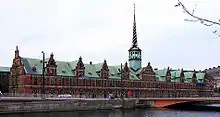 |
| Rosenborg Castle | 1606–1624 | Built in the Dutch Renaissance style by Architects Bertel Lange and Hans van Steenwinckel |  | |
| Hillerød | Frederiksborg Palace | 1602–1620 | Dutch Renaissance style (architects Hans and Lorents van Steenwinckel) |  |
Germany
| Place | Building | Main period of construction | Special features | Image |
| Friedrichstadt | Market Square | early 17th century | Plastered brick |  |
| Lübeck | Mühlentor | 1550s (model) |  | |
| Schiffergesellschaft | 1535–1538 | 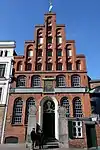 | ||
| Zeughaus | 1594 | 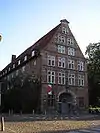 | ||
| Reinbek | Castle | 1572–1576 |  | |
Italy
| Place | Building | Main period of construction | Special features | Image |
| Ferrara | Castello Estense | 1385–1450, early 16th century | The castle essentially presents the appearance given to it by Girolamo da Carpi in the second half of the 16th century | 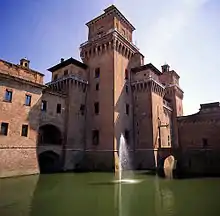 |
| Milan | Castello Sforzesco | 14th century, 1450 |  | |
Lithuania
| Town/city | Building | Main period of construction | Special features | Image |
| Vytėnai | Panemunė Castle | 1604–1610 |  | |
| Raudondvaris | Raudondvaris Castle | 16th century, 1615 | Rebuilt 1653–1664 |  |
| Siesikai | Siesikai Castle | c. 1517 | 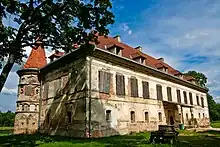 | |
| Jonava | St. Anne's Church in Skaruliai | c. 1622 |  | |
Poland
| Place | Building | Main period of construction | Special features | Image |
| Brochów | Fortified church | 1551–1561, 1596 | Gothic-renaissance church established by Jan Brochowski and his family as a three-nave church with three side towers | 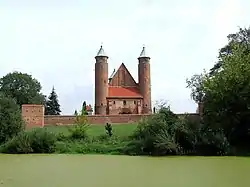 |
| Bydgoszcz | Church of the Assumption of Mary | 1582–1645 | 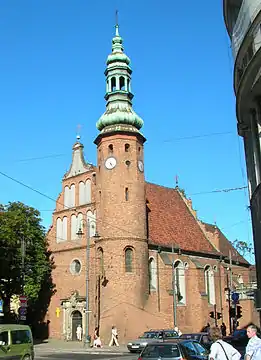 | |
| Gdańsk | Green Gate | 1564–1568 | Example of the Flemish mannerism in the city inspired by the Antwerp City Hall (architect Regnier van Amsterdam)[1] |  |
| Old Arsenal | 1602–1605 | Built in Dutch/Flemish mannerism by Anthonis van Obbergen, Jan Strakowski and Abraham van den Blocke[2] | .jpg.webp) | |
| Gołąb | Church of St. Catherine and St. Florian | 1628–1638 | Polish mannerism style |  |
| Grocholin | Fortified manor house | 16th century | Built for Wojciech Baranowski, is a rare example of defense housing architecture in northern Poland[3] |  |
| Piotrków Trybunalski | Royal Castle | 1512–1519 | Gothic-renaissance | .jpg.webp) |
| Płock | Płock Cathedral Dome | 1531–1534 | Romanesque cathedral, rebuilt several times |  |
| Pułtusk | Collegiate Church Pułtusk vault | 1551–1556 | Renaissance frescoes on the vault cover more than 1000 square meters in total[4] (brick church built between 1449 and the first half of the 16th century) |  |
| Sandomierz | Town Hall | 14th century | Rebuilt in the renaissance style in the 16th century |  |
| Supraśl | Orthodox Monastery - Church of the Annunciation |
1503–1511 | Gothic-renaissance, destroyed in 1944 by retreating German army,[5] rebuilt since 1985 |  |
| Tarnów | Mikołajowski House | 15th century | Rebuilt in the renaissance style in 1524 |  |
| Town Hall | 14th century | Rebuilt in the renaissance style in the 16th century | 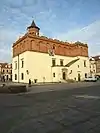 | |
| Zamość | Zamość Fortress | 1579–1618 |  | |
Sweden
| Place | Building | Main period of construction | Special features | Image |
| Kristianstad | Holy Trinity Church (Swedish: Helga Trefaldighetskyrkan) | 1617–1628 | The city of Kristianstad was founded by king Christian IV of Denmark in 1614 at a time when Scania was part of the Kingdom of Denmark (until 1658). | 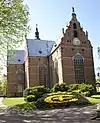 |
| Mariefred | Gripsholm Castle | 1537– | Built on the site of a medieval castle, which is partly preserved in the current castle. | 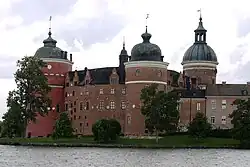 |
| Stockholm | Swedish House of Nobility (Swedish: Riddarhuset) | 1641–1675 | The building is more or less unchanged since its construction. |  |
| Trolle Ljungby | Trolle Ljungby Castle | 1620s–1630s | The castle was mainly constructed when Scania was part of the Kingdom of Denmark (until 1658). |  |
References
- ↑ Juliette Roding; Lex Heerma van Voss (1996). The North Sea and culture (1550–1800): proceedings of the international conference held at Leiden 21–22 April 1995. Uitgeverij Verloren. p. 103. ISBN 90-6550-527-X.
- ↑ Lech Krzyżanowski; Michał Wożniak; Marek Źak; Wacław Górski (1995). Beautiful historic Gdańsk. Excalibur. p. 769. ISBN 9788390343150.
- ↑ "Historia". www.grocholin.pl (in Polish). Retrieved 2009-12-17.
- ↑ Paweł Giergoń. "Pułtusk Kolegiata p.w. Zwiastowania NMP". www.sztuka.net (in Polish). Archived from the original on 2011-10-03. Retrieved 2009-12-17.
- ↑ "Geschichte". www.monaster-suprasl.pl (in German). Archived from the original on May 1, 2008. Retrieved 2009-12-17.